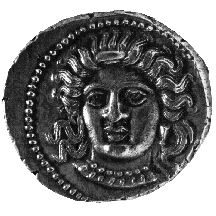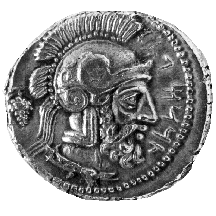



(38) Tarsos, Cilicia (Turkey) - AR stater, c. 378-372 B.C.,
10.73 g. (inv. 91.088).
Obverse: Facing female head.
Reverse: Helmeted and bearded head of Ares/satrap
r.; bunch of grapes in l. field; in r. field, ![]() : the name Datames in Aramaic.
: the name Datames in Aramaic.
Provenance: Ex Frederick Knobloch collection; Stack's,
1970.
Bibliography: P. Naster, "Les statères ciliciens
de Pharnabaze et de Datame à types communs," Kraay-Mørkholm
Essays; Numismatic Studies in Memory of C.M. Kraay and O. Mørkholm,
G. Le Rider et al., eds. (Louvain-la-Neuve 1989) 191-201.
Tarsos was one of a number of partially Hellenized cities along the southern
coast of Asia Minor that were subjects of Persia in this period. In the
370's the mint at Tarsos issued coins for the satraps (provincial
Persian governors) Pharnabazus and Datames, joint commanders of an expedition
to recapture Egypt. For this purpose they issued a large number of coins
apparently designed to appeal simultaneously to their own subjects and to
the Greek mercenaries in the force. The coins relied heavily upon Greek
prototypes.
The female head on the obverse of this coin was inspired by the famous facing
head of the nymph Arethusa by Kimon on late fifth-century Syracusan tetradrachms
(see no. 17). Many Greek cities had also adapted
the famous image for their coins (see nos. 25, 27,
28, 34, 36).
Whether at Tarsos the head was given a specific local identity or whether
it was simply appropriated because of its associations with well-known Greek
coins is unknown. On the reverse is the head of a bearded warrior in an
elaborate helmet with upturned cheek-piece. Although the figure is male,
the image was probably modelled on the helmeted Athena of Attic tetradrachms
(see no. 30). Persians and others able to read the
Aramaic name to the right of the head would have recognized in it their
leader Datames, although the fact that the same type was used for Pharnabazus
indicates that the head was not actually a portrait. The Greek mercenaries
at the same time could have seen it as their war god, Ares. The bunch of
grapes behind the head may also refer to the fertility god Ba'al, who is
depicted holding a bunch of grapes on other coins of this time issued by
Datames.
C.L.L.



All contents copyright (c) 1996.
Lawrence University
All rights reserved.